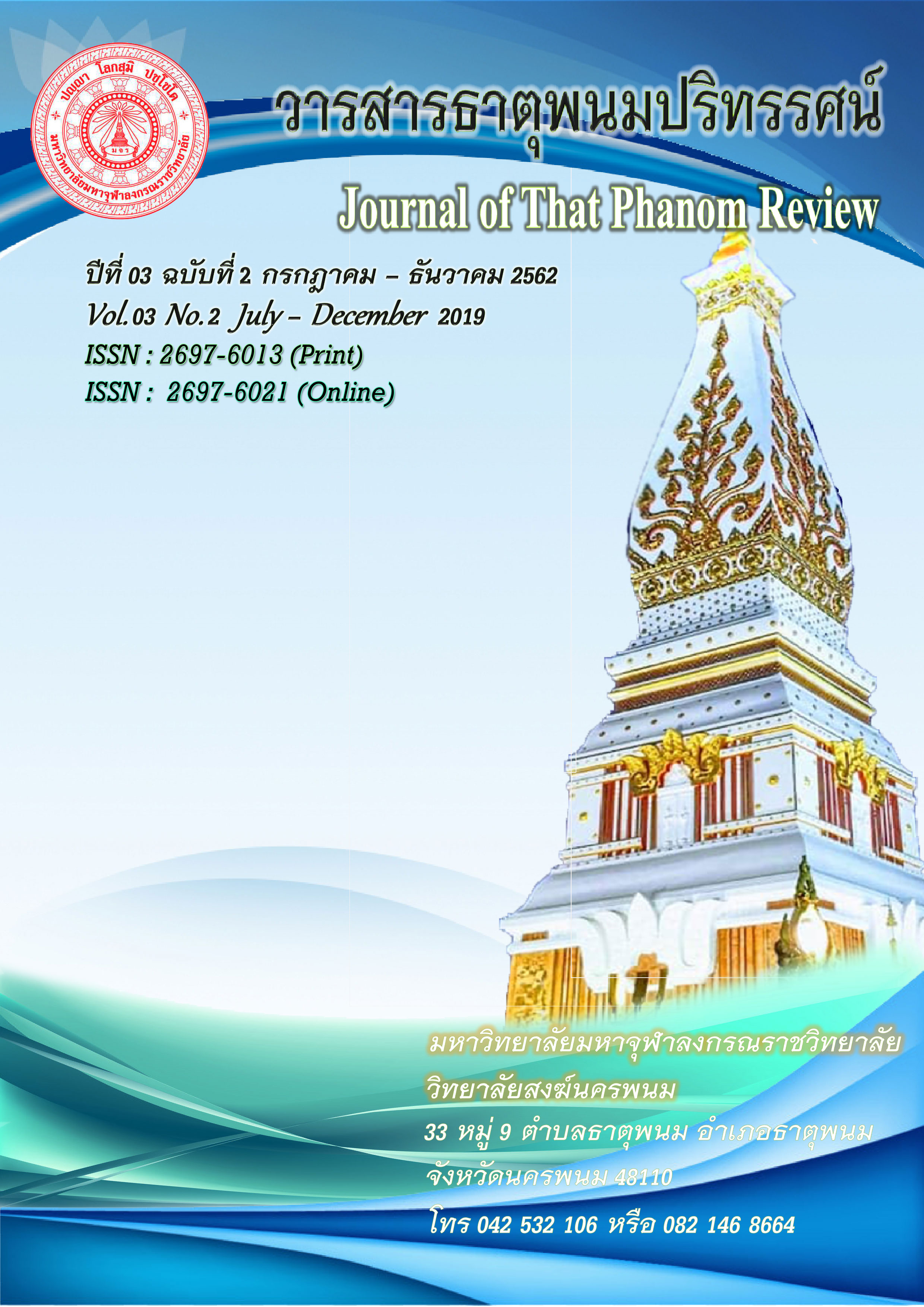Decision-making Behavior of Hotel Customers in Loei
Keywords:
Decision behavior, Loei Province
Abstract
The objectives of the research were (1) to study decision-making behaviors of hotel customers in Loei for the sake of hotel operators to use as guidelines to develop business and to meet the demand of customers and (2) to study recommendations and problem resolutions of hotel operators in Loei. The population of the research was comprised of hotel operators in Loei and the samples of 400 respondents. The research statistics used for the data analysis were comprised of frequency distribution, percentage, arithmetic mean and standard deviation, including the descriptive statistics. The research findings were as follows: 1. The decision-making behavior of hotel customers in Loei was found to be overall at a high level of 3.90. Considered in each aspect, six aspects were found to be at a high level and an aspect was found to be at a moderate level. The aspect with the highest level of the mean 4.11 was the physical characteristics, followed by the price 4.09, and the aspect with the lowest level of the mean 3.26 was the hotel process. 2. The recommendations of hotel customers in Loei were found in summary that the cleanness of resorts and hotels was required, the regular improvement of their environment and services as required, the price of rooms and services were required reasonable, not very costly, and compatible with the service quality and the locality. The interior of the hotel should look clean all the time and the area of the hotel was required sufficient space for car parking. Membership was required for the member’s point accumulation or discount. The customer’s requirements were public relations through various kinds of media, reliable security measures for the customer’s assets, and instant services. Another requirement was also found that sufficient polite service-minded employees with good manners should be assigned to provide customer services.References
กัลยา วานิชย์บัญชา. (2548). การใช้SPSS for Windows ในการวิเคราะห์ข้อมูล. (พิมพ์ครั้งที่ 6). ภาควิชาสถิติคณะพาณิชยศาสตร์และการบัญชี จุฬาลงกรณ์มหาวิทยาลัย.
คุณัญญา พรหมปัญญานันท์ และนิตนา ฐานิตธนกร. (2557). ปัจจัยสื่อสังคมออนไลน์ความสัมพันธ์กับลูกค้าคุณภาพความสัมพันธ์และการรับรู้ถึงคุณภาพของสินค้า ที่มีผลต่อการตัดสินใจใช้บริการร้านเบเกอรี่คาเฟ่ของผู้บริโภคชาวมุสลิมในเขตกรุงเทพมหานคร. มหาวิทยาลัยกรุงเทพ.
ธัญพรนภัส แฟงสม. (2556). แนวทางการพัฒนาการตลาดของโรงแรมระดับ 4 ดาวเครือภายในประเทศในเขตเมืองพัทยา.โรงแรมรามาดา เดมา กรุงเทพ.
นิตนา สุริศักดิ์ (2553). การประกอบการเพื่อสังคม: นวัตกรรมทางสังคมของผู้ประกอบการยุคใหม่,วารสาร นักบริหาร, 30(4), 16-20.
ประภัสสร ชัยวัง. (2556). พฤติกรรมการเลือกที่พักของนักท่องเที่ยวอำเภอปาย จังหวัดแม่ฮ่องสอน.คณะเศรษฐศาสตร์ มหาวิทยาลัยเชียงใหม่.
พิทยุตสม์ สงค์มาลัย และนิตนา สุริศักดิ์ (2553). การศึกษาปัจจัยส่วนประสมทางการตลาดที่มีอิทธิพลต่อการตัดสินใจใช้บัตรสมาร์ทเพิร์สในเขตกรุงเทพมหานคร.BU Academic Review. 9(2) : 45 – 53.
ภัทราพร เกษสงข์ . (2549). การวิจัยทางการศึกษา. เลย : มหาวิทยาลยราชภัฏเลย .
ศิริวรรณ เสรีรัตน์ . (2546). กลยุทธ์การตลาด. กรุงเทพฯ : โรงพิมพ์บรรณกิจ.
สำนักงานสถิติจังหวัดเลย. (2559). สืบค้นวันที่ 5 พฤศจิกายน 2559 จาก http://loei.nso.go.th /loei/index_oldversion.htm.
Rovinelli and Hambleton (1977). On the use of content specialists in the assessment of criterion-referenced test item validity. Dutch Journal of Educational Research, 2, 49-60.
คุณัญญา พรหมปัญญานันท์ และนิตนา ฐานิตธนกร. (2557). ปัจจัยสื่อสังคมออนไลน์ความสัมพันธ์กับลูกค้าคุณภาพความสัมพันธ์และการรับรู้ถึงคุณภาพของสินค้า ที่มีผลต่อการตัดสินใจใช้บริการร้านเบเกอรี่คาเฟ่ของผู้บริโภคชาวมุสลิมในเขตกรุงเทพมหานคร. มหาวิทยาลัยกรุงเทพ.
ธัญพรนภัส แฟงสม. (2556). แนวทางการพัฒนาการตลาดของโรงแรมระดับ 4 ดาวเครือภายในประเทศในเขตเมืองพัทยา.โรงแรมรามาดา เดมา กรุงเทพ.
นิตนา สุริศักดิ์ (2553). การประกอบการเพื่อสังคม: นวัตกรรมทางสังคมของผู้ประกอบการยุคใหม่,วารสาร นักบริหาร, 30(4), 16-20.
ประภัสสร ชัยวัง. (2556). พฤติกรรมการเลือกที่พักของนักท่องเที่ยวอำเภอปาย จังหวัดแม่ฮ่องสอน.คณะเศรษฐศาสตร์ มหาวิทยาลัยเชียงใหม่.
พิทยุตสม์ สงค์มาลัย และนิตนา สุริศักดิ์ (2553). การศึกษาปัจจัยส่วนประสมทางการตลาดที่มีอิทธิพลต่อการตัดสินใจใช้บัตรสมาร์ทเพิร์สในเขตกรุงเทพมหานคร.BU Academic Review. 9(2) : 45 – 53.
ภัทราพร เกษสงข์ . (2549). การวิจัยทางการศึกษา. เลย : มหาวิทยาลยราชภัฏเลย .
ศิริวรรณ เสรีรัตน์ . (2546). กลยุทธ์การตลาด. กรุงเทพฯ : โรงพิมพ์บรรณกิจ.
สำนักงานสถิติจังหวัดเลย. (2559). สืบค้นวันที่ 5 พฤศจิกายน 2559 จาก http://loei.nso.go.th /loei/index_oldversion.htm.
Rovinelli and Hambleton (1977). On the use of content specialists in the assessment of criterion-referenced test item validity. Dutch Journal of Educational Research, 2, 49-60.

